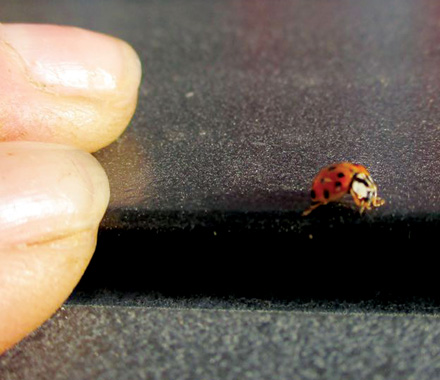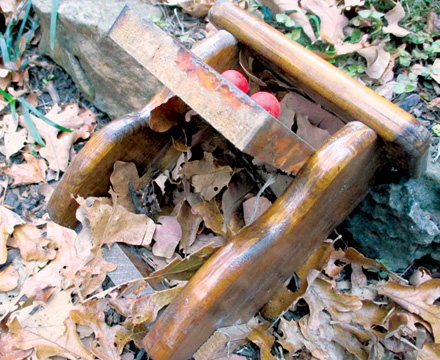Invasion of the Asian Ladybug

You’ve seen them, haven’t you, sitting on a windowsill, lurking in a corner, maybe even walking across a piece of furniture? This could be the title of one of those B-rated horror movies if it didn’t involve something as cute as a little red ladybug, something most people associate in a positive light. Until recently.
The normally welcome red ladybug (Hippodamia convergens) a beneficial garden insect that consumes its weight in aphids daily, has a multi-colored cousin, the Asian ladybug or lady beetles. These similar-looking beetles are yellow, orange, green and sometimes mistaken for red ladybugs. This time of year, they look for warm places to winter over, especially white buildings and siding, which mimic their native rock where they would normally bury into crevices.
I used to work for a US Department of Agriculture agency and periodically someone would call and chew me out for having imported these bugs into North America. The US Forest Service didn’t but USDA did repeatedly bring them in, starting in 1916 as a biological control agent to help pecan growers in Georgia. This tree dwelling beetle, Harmonia axyridis (Pallas) is a predator of aphids and scale insects.
According to Penn University Extension, the Asian ladybug was originally released in Pennsylvania in 1978 and 1981, but the first overwintering beetles were not recorded until 1993. This beetle’s recent population increase in Louisiana, Pennsylvania, and other northern states may not have resulted from the earlier USDA releases. Instead, they are thought to be from a new source that was accidentally introduced in New Orleans from an Asian freighter.
Regardless of how they got here, they are now definitely here. This year has been worse than some in part due to the mild winter we had last year. To remove them, it is recommended they be vacuumed with the understanding they will leave a yellow stain in the vacuum tube and bag. Do not sweep or otherwise squish these bugs because they will not only leave a yellow stain but release an acrid odor as well.
In terms of native North American ladybugs, there are more than 400 species. They range from solid black to the traditional red with black spots and they are also natural biological control species, eating mealy bugs, aphids and other soft-body insects.
To encourage native ladybugs in your garden, you can buy ladybug houses where leaves can be added so the insects have a place to safely winter over.
One of my brothers gave me a shipment of ladybugs for my birthday years ago. Once they arrived, I realized I had to find a food source. For the first time in my life I was thrilled to find a few aphids growing under mint leaves so I released the ladybugs there.
Although ladybugs can be purchased, that is not encouraged because most suppliers are capturing wild populations and shipping them to different parts of the country, thereby depleting local populations. It is better to encourage native populations to establish themselves and fit into garden ecosystems.
Charlotte Ekker Wiggins is a beekeeper, gardener and sometimes cook. Published by El Dorado Springs Sun once in print and online with author’s permission. Copyright 2017, all rights reserved. This column may not be reprinted, republished or otherwise distributed without author’s permission. Contact Charlotte at gardeningcharlotte at gmail dot com.

FRIEND OR FOE? – Is this a native ladybug or Asian ladybug? See the black M on the white head? That’s an Asian ladybug, which also may have up to 22 black spots and come in a variety of colors besides red.

BUG HOUSE – This is a native ladybug house that encourages native ladybugs to winter over in the enclosed leaves. Asian ladybugs prefer white surfaces and haven’t been found in leaves. (Photos by Charlotte Ekker Wiggins).



Facebook Comments